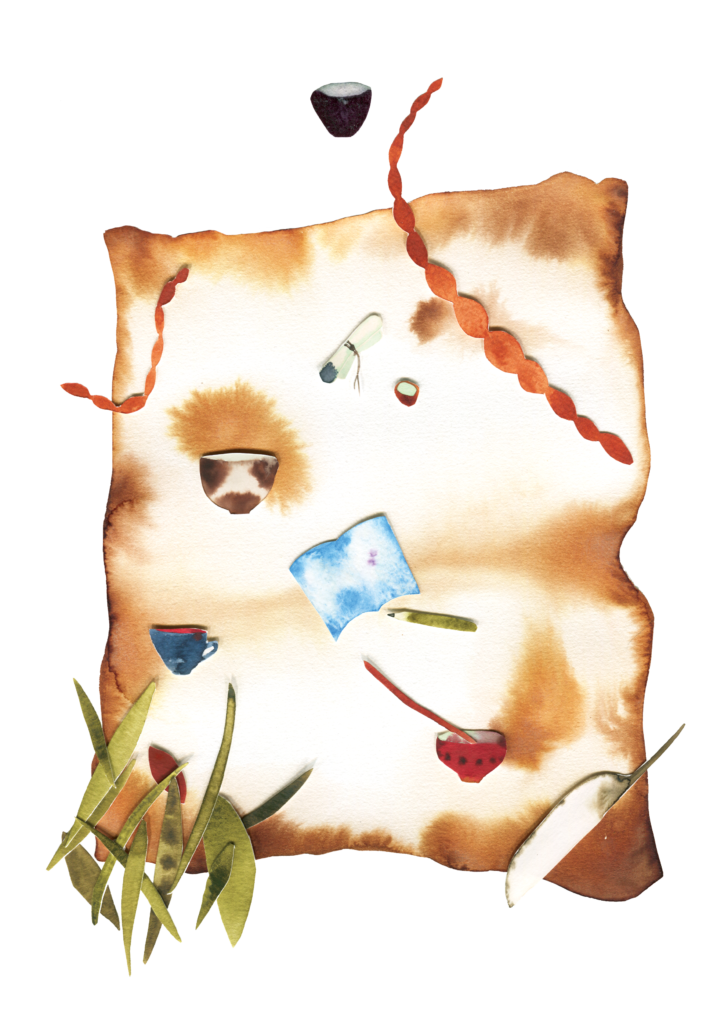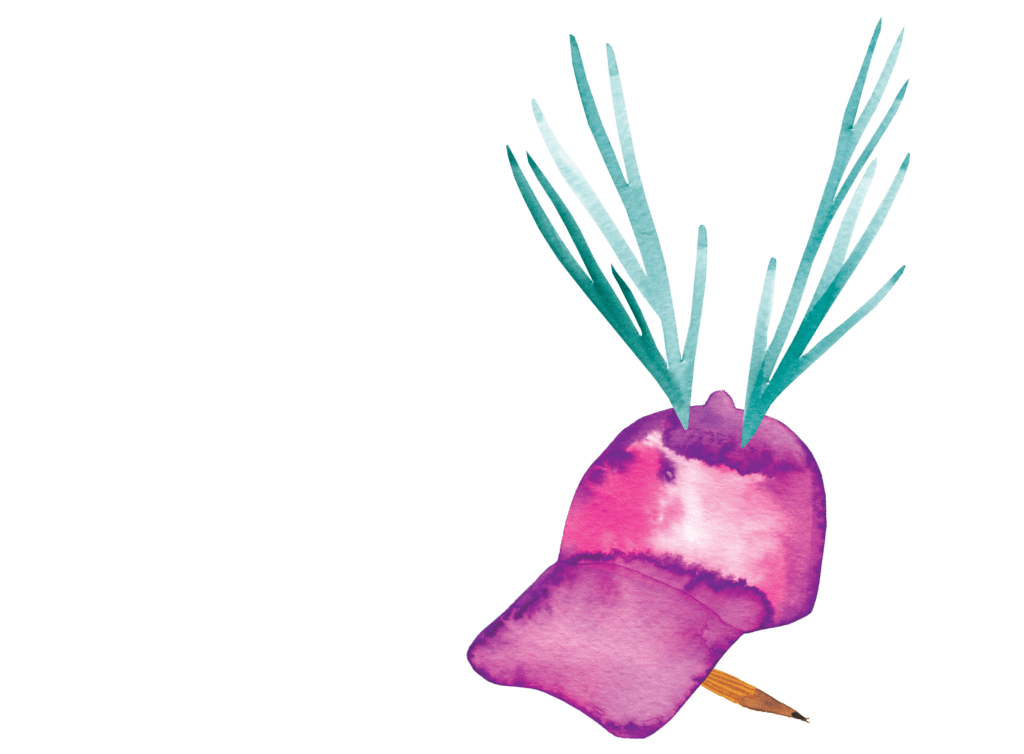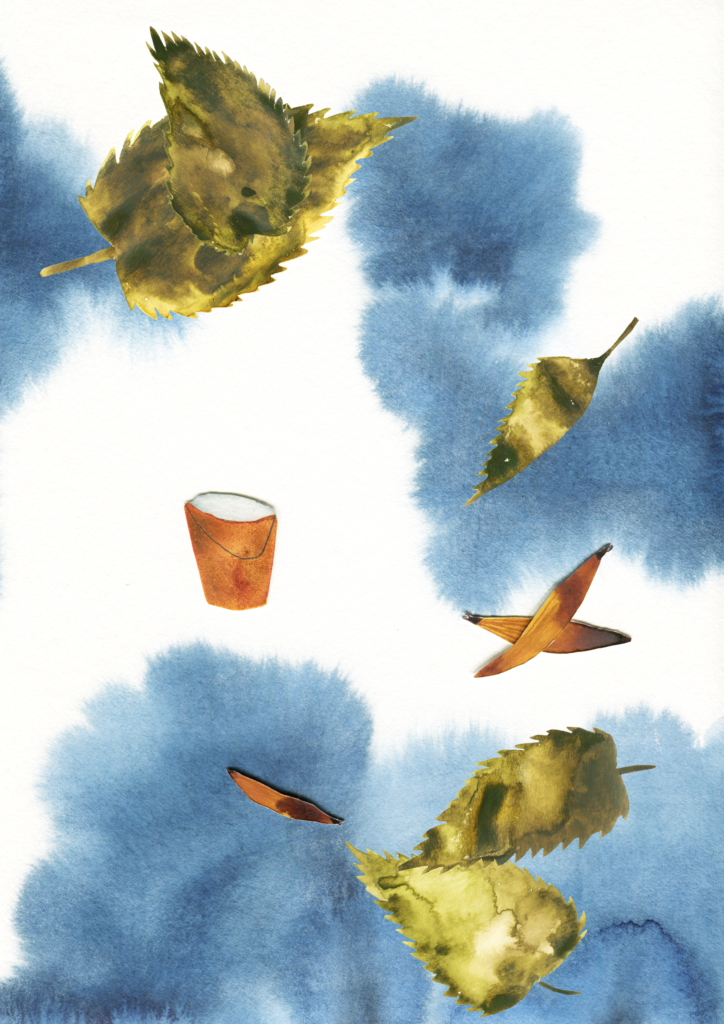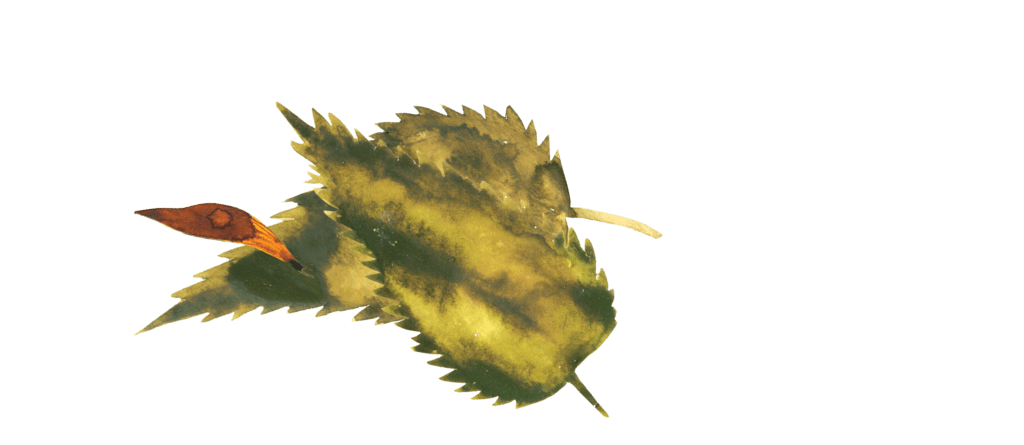
The global environmental crisis brings a new challenge to educators: How to best encounter the various emotions and attitudes towards environmental issues existing in a group? How to support young people’s growth towards more sustainable values and lifestyle? In this introduction chapter, you will get perspectives on addressing environmental themes with young people. In addition, you will learn about creative writing as an environmental pedagogical tool.
The global environmental crisis and climate change stir a variety of emotions. Having to give up familiar living environments and habits can inspire for example anxiety, sadness, fear, guilt, or hate. On the other hand, nature experiences and participation in ecological activism can spark, for example, joy, gratitude, feelings of togetherness, and excitement.
Young people are in a particularly vulnerable position
regarding climate change. Some young people experience
severe environmental anxiety, and their view of the future
is bleak. At the same time, young people want more information
about concrete opportunities to make an impact,
and demand that decision-makers act responsibly and
courageously. On the other hand, young people also have
many other worries and emotional turbulences that are
part of the stage of life they are going through, and some
young people are completely uninterested in thinking
about environmental problems. This puts educators in a
challenging position: How to best encounter the various
emotions and attitudes towards environmental issues
existing in a group?
Even difficult environment-related emotions can be turned into a strength if the individual is in a position that allows them to address these emotions and has sufficient opportunities to act to combat climate change. Thus, both young people and adults have a need to address their environmental emotions in a safe group and a need for opportunities to consider their own environmental activism and to take action. Addressing these issues with young people using, for example, artistic methods can increase the acceptance towards differing emotions and attitudes. Encountering various emotions is important for learning to live with our own emotions.
Being able to address one’s emotions can also increase the freedom of choice about the way an individual chooses to channel their emotional energy. For example, directing the energy of anger caused by environmental issues into environmental action can be a fruitful choice. Thinking about environmental activism and taking action in a group can support young people’s confidence in adults taking environmental issues seriously and them being willing to take action together with the young people. In addition to the desire to have an impact, hope and a sense of the meaningfulness of life are also needed – and participation in environmental action plays a central role in strengthening hope. Environmental researcher Panu Pihkala says that hope can be viewed as an attitude that holds on to the meaningfulness of life even when there is no guarantee of success.
Some high-quality materials to support addressing environmental emotions have been published in the recent years. The web page An Existential Toolkit for Climate Justice Educators is one example. The Climate Change in Me creative writing teaching kit adds to the educators’ toolkit versatile creative writing exercises that can be used on their own, or together with other materials that address the subject.

How to Read This Teaching Material?
This teaching material consists of creative writing exercises for addressing environmental emotions, sustainable future, and environmental activism together with young people. The goal of the exercises is to create space for hearing and sharing environmental emotions in a safe group, for expanding the imagination about the possible futures, and for considering each participant’s own role as an environmental actor.
The exercises in this material contribute to the aims set in the Finnish national core curriculum for basic and secondary education including ecosocial knowledge and competence, cultural competence, interaction and self-expression competences, multiliteracy competence, well-being competence, multidisciplinary and creative competence, and participation, involvement and building a sustainable future. Even though the exercises utilize creative writing as the method, many of them are suitable to be used for many other subjects, for instance for geography, biology, health education or emotional and interactive skills lessons.

At the same time, the exercises also introduce various areas of literary art. Literary art means creative literary expression that is based on a broad understanding of texts. Texts can be produced, for example, through writing, speaking, or making illustrations, or in an audiovisual and digital form. The exercises in this teaching material emphasise the joy, play, and experientiality that are central to literary art. The exercises encourage the use of imagination and insight through their use of various text types and genres. The teaching material introduces experiments with various creative writing methods from inventing new words to creating poems, letters, stories, advertisements, and recipes. Thus, the material is also suitable for developing linguistic, interactive and textual competences in literary art and creative writing groups and as part of teaching the first language and literature subjects.
The exercises in this material are particularly suitable for students in lower or upper secondary education and for adults, but some of them can also be adapted for younger target groups. When working with children, it is a good idea to emphasize action instead of talking, and address environmental questions in a manner that is appropriate for the children’s age level. The level of difficulty varies between the exercises and it is a good idea to pay specific attention to how the exercise can be conducted in a safe way, with respect to the privacy of all participants.
Some exercises are more easily applied to school context, while some of them are more suited for groups interested in creative expression, such as literary art groups. In a multilingual group, it is a good idea to encourage the participants to write in their native language to make it easier to verbalise personal emotions and experiences. The thoughts stirred by writing can then be shared in a language that is understood by the members of the group.
The first chapter of this teaching material, titled “Environmental Emotions”, is about verbalizing, expressing and experiencing physically, and sharing personal environmental emotions in a group. The exercises in the second chapter, “A Sustainable Future”, deal with observing one’s thinking about the future and expanding one’s imaginative capacity by imagining a sustainable culture. In the third chapter, “Me as an Environmental Actor”, students are encouraged to reflect on their own values and the opportunities that are available to them to have a concrete impact on climate issues. Finally, there are three lesson plan examples, one for each chapter’s theme.
The exercises in this teaching material have been grouped
in such a way that each chapter begins with easy-to-approach
warm-up exercises that are suitable for starting
a group session. The goal of these warm-up exercises is
to create a safe atmosphere and an appropriate level of
alertness for working in a group. At the same time, the
warm-up exercises gently help the participants to tune in
to the theme of the chapter. As an educator, you can, for
instance, choose one or two warm-up exercises that you
feel are suitable for your group, and after that do a main
exercise related to the theme – you are the expert on your
group and know best what works with your group. Based
on the exercises, you can also develop follow-up exercises
for your group, such as developing texts further using
other art forms.
Each main exercise includes a short “tuning in” section to
get oriented with the theme and the exercise itself. It is a
good idea to allocate enough time after each exercise and
group work session for sharing the texts or other works
that have been produced, and for discussion.

Exploring Environmental Themes with Young People
Addressing environmental emotions is needed both as a part of general pedagogy and lessons related to environmental themes and, particularly, when strong emotions are stirred in a group by, for instance, a topical environmental news item or by participating in a demonstration on an environmental issue. Young people and adults both have differing emotions and attitudes regarding environmental issues, and different individuals are also at different stages of the process of addressing and dealing with the environmental crisis. Some young people are uninterested in thinking about the topic, some may wish to get more information, some may need opportunities for sharing their feelings, and in case of some, correcting erroneous ideas or stereotypes may be needed. The mere fact that young people don’t talk about the topic should not be viewed as a proof of their interest or a lack thereof. Rather, working with young people requires both time and trust. Indifference can sometimes be a protective emotion that helps the individual by enabling them to avoid experiencing more uncomfortable environmental emotions.
Educators can adapt the way environmental themes are addressed according to their own strengths. The most important thing is, at the very least, to verbalize the existence of environmental emotions in their group. For example, an educator can use the phrasing suggested by the Toivoa ja toimintaa (“Hope and Action”) project: “I understand well that many of you have various difficult emotions regarding, for example, climate change and other issues related to sustainable development. They are such big and distressing problems that us educators also have many difficult emotions regarding them. However, it is possible to live with those emotions together with other people.” (Kemppainen et al. 2019.) For many young people, the mere fact that an educator admits that they too have difficult emotions regarding environmental crisis can help them feel better. The educator can also, within the limits set by their own skills, offer opportunities to discuss emotions and then progress to art based teaching methods.

Before conducting emotional group work, the educator is advised to explore their own environmental emotions in order to avoid projecting their own emotions to the group and to be able to support the participants’ emotional processes. It is also a good idea for the educator to try to do the exercises themselves before doing them with a group.
When addressing environmental issues, a listening and non-judgemental attitude is particularly important. When starting to work on this theme, the educator can explicitly state that expressing any and all emotions and attitudes is allowed in the group, but on the other hand, there is no obligation to feel or to express anything. One goal in the group is to respect other people’s feelings and attitudes without trying to change them. With young people, creating a safe atmosphere is crucial, as young people can be wary of sharing distressing experiences even in a familiar environment and social context. More generally, people in industrial societies are not used to discussing emotions, such as sorrow, that can seem daunting. Because of this, it is important to give everybody an opportunity to be heard and accepted while also protecting the participants’ privacy. Various methods suitable for sharing thoughts anonymously such as, for instance, the AnswerGarden platform or other word cloud applications, can be utilized for sharing experiences, and discussions can also be conducted in pairs, which avoids having to share with the entire group.
An educator should try to be sensitive in observing the group’s wishes and needs at any given moment. For some groups, the current need may be addressing and exploring environmental emotions, while some other group may need an opportunity to take concrete action. It is recommended, however, to include both emotional work and practical action in every teaching module. The needs of a group may change, so the educator should be ready to revise their plans as needed.
Different exercises can be used to discover a balance between serious and lighter themes. Difficult emotions are sometimes easier to address using a distancing element, such as turning them into poems or song lyrics. Humour is also an important survival tool, and laughing together in the context of artistic work can be a source of relief. Reflecting on one’s personal relationship with nature by being active out in nature or by writing outdoors can offer breathing room amidst weighty issues.
As the environmental crisis is an enormously complex issue, many educators may feel hesitant about whether they have sufficient theoretical capabilities and a sufficient skill set to address such a challenging topic. Both young people and adults living on a planet that’s undergoing a change are facing the new and the unknown. So, environmental issues can be addressed with an inquiring approach, with compassion, accepting one’s own incompleteness. If the educator is open to wonder and investigate and to come up with opportunities for taking action together with the young people, that is enough!
The ethical task of an educator is to maintain meaningfulness and in that sense also to maintain hope. At the same time, it is important that the educator does not belittle environmental issues and that there is opportunity in the group to examine also the difficult emotions without an attempt to force them to turn into positive ones. While accepting the negative emotions, it is also possible to bring to mind perspectives that create and strengthen hope, such as the fact that news coverage is often problem-centric, and that many positive things that alleviate the environmental issues are also happening in the world. Besides environmental problems, there are also many other global issues, such as the pandemic and wars, all of which can create pressures on the young people. Therefore, it is important to be able to discuss climate change with young people in a way that, instead of causing more anxiety, offers them constructive ways to cope.
Providing information about opportunities to have an impact also creates hope, but at the same time it is a good idea to remind young people about the importance of self-compassion. An individual should not belittle the impact they can have, but it is also important to take care of one’s personal well-being and manage stress. It is important to note that even though climate change is essentially a challenge faced by the entire humankind together, young people are on unequal footing when it comes to environmental action. For instance, because of financial factors, all people do not have an equal opportunity to change their consumer habits. It is important to avoid making young people feel guilty over their choices, and important for adults to admit that they bear the main responsibility for reacting to the environmental crisis.
When addressing themes of environmental activism, the educator can, for example, remind the students about the view of environmental philosopher Joanna Macy: everyone can discover their own way of having an impact on environmental problems that fits their personal talents. Even small actions can have far-reaching consequences. It is also a good idea to remind the group about the importance of collective action. Environmental issues are such large-scale challenges that no-one can solve them alone. Instead of individual heroism, wide-spread civil activism, as well as cooperation between corporations, decision-makers, and grass-roots actors are needed both on national and international levels.

Creative Writing as a Method in Environmental Pedagogy
Art-based methods facilitate more holistic and more physical ways of addressing environmental issues, creating space for alternative ways of knowing and for getting acquainted with the idea of multi-species relationships. In such pursuits, creative writing is particularly useful as a method. Many people are already familiar with writing, and writing as a method makes it possible to address one’s own feelings, thoughts, and experiences in a safe, private way. Studies in literary therapy show that writing about difficult emotions and experiences can improve both physical and mental well-being and support the development of positive coping strategies. New tools utilizing creative writing have indeed been developed in recent years for addressing environmental issues.
The use of creative writing to address the environmental crisis can have various goals. Writing can help mobilize emotions and to make an individual more aware of their own emotions. At the same time, writing creates distance between an individual and their emotions and helps them to organize their thoughts. Sharing texts in a group offers a glimpse into the inner world of other writers. Consuming art and literature as well as creating them can indeed improve empathy skills if the learning context employs pedagogic methods that encourage empathetic interaction.
Various writing experiments can also be utilized to discover a new kind of relationship with nature and to imagine the world from a non-human perspective. Using writing as a means to pause and observe natural phenomena helps to notice how the mind, body, other species, and natural processes all interact with each other. At the same time, strengthening one’s emotional bond with nature can increase the motivation to take care of the environment.
Story-telling can be used to influence the kind of future we want to create – for example by imagining inter- species coexistence and cooperation instead of individualistic heroism. Because teaching materials for language and literature often use dystopias to address environmental issues, utopic work is emphasized in this teaching material. Dark tales of the future can be helpful in facing and addressing personal fears, but stories that increase confidence and excitement and portray the future in a more diverse manner are needed to balance the picture. In the view of future studies, there are many futures, some of them more and some less likely, and the probability of the realization of any of them can be affected by personal action. To change the world, we do indeed need to expand what is imaginable and be able to think about future in a constructive way.

Creative writing can strengthen the participants’ motivation for taking environmental action, and writing can be also used to plan concrete environmental actions. Survey data gathered from the Ilmastonmuutos minussa (“climate change in me”) creative writing workshops for adult participants that I ran (in 2018–2020) shows that the use of writing to reflect on environmental emotions and one’s personal role as an environmental actor sparked in some course participants a desire to have an impact on environmental issues. Writing in itself can also be one method of environmental activism, along with other activities.
For quite some time, creative writing has, however, been relegated to a secondary role as a method in literary environmental pedagogy, with the main attention being focused on the importance of reading. Similarly, literary art pedagogy in general has not been sufficiently studied. The broad potential creative writing has in environmental pedagogy does indeed deserve more attention. As a method, creative writing is adaptable to diverse experiments: texts can be written collaboratively one sentence at a time, multi-sensory experiences such as movement or music can be used as the point of departure for writing, and the texts that have been produced can be interpreted physically, through painting, or through sculpting. It is useful to experiment without prejudice with writing outdoors as well, in different environments and weather conditions. Writing in nature can facilitate new sensory and emotional experiences and inject texts with more sense of surprise and physicality.
Creative writing can also be incorporated to multidisciplinary teaching modules. An example could be a study module including geography, home economics, health education, and language and literature that covers the causes and effects of climate change, the opportunities to have an impact on and to prepare for climate change, and the verbalization of emotions that stem from climate change using creative writing. A multidisciplinary module to address environmental emotions could include music, language and literature, and visual arts, with the students producing rap videos about environmental emotions. As many of us are familiar with writing as a working method, it is also particularly well suited as a warm-up activity for various group activities, for reflecting on themes that have been covered, and for probing one’s own thoughts and emotions before sharing them with a group.
When addressing environmental themes using creative writing as a method, the main thing is the process, not the end result or its evaluation. It is not necessary to share the written text with other participants, but it can also be revisited by reading it alone and underlining important parts, or by reading it together with a trusted friend. For young people in particular, it can be more comfortable to share only isolated words or fragments of their texts. The fragments can be used to create word collage poems on the classroom wall – or in distance learning context, in a chat group – or to create collaborative soundscapes by repeating aloud the words that are said by other participants. In the process, the words shared by the participants form a new text that can be a source for exhilarating associations and a sense of community and shared creation. If the group is safe enough for the sharing of texts, short encouraging feedback can be given for texts that have been worked further. The group or the teacher can, for instance, tell which qualities or parts of the text they liked and what thoughts related to the theme covered were inspired by hearing the text.
For some young people, creating text independently can be a challenge. The culture of digital media has made other means of expression more familiar. Similarly, for instance young immigrants or other special groups may have difficulties producing text because of their level of language skills or because of other challenges related to verbal and/or literary expression. Various collage techniques that make use of existing texts make participation easier, as the student can put their text together using pre-existing materials. Using pre-written sentence openings or a text scheme to guide writing, or writing free stream of consciousness can also help in getting started. Knowing that sharing the text with others is not mandatory can be helpful at keeping self-criticism at bay.
Young people’s attitudes towards writing and art-based work also vary. The educator can remind participants that when doing creative writing exercises, one does not need to consider the rules of grammar, that there are no right or wrong ways to write. Creative writing gives the licence to try things that are new and irrational, to play with words, and to welcome even the weirdest of associations! Creative writing develops young people’s emotional skills and their awareness of environmental emotions. They are given an opportunity to imagine themselves as climate heroes, animals, news reporters, authors, inventors, citizens of a sustainable city of the future, and in other roles where their lives are affected by climate change. This is the mobilizing force of imagination.

References
Atkinson, Jennifer & Kelsey, Elin & Ray, Sarah Jaquette (eds.) 2021: An Existential Toolkit for Climate Justice Educators, https://www.existentialtoolkit.com
Burkhart, Jocelyn 2016: “Singing the spaces: Artful approaches to navigating the emotional landscape in environmental education.” Canadian Journal of Environmental Education, 21, 72–88.
Easterling, Brian A. & L’Abate, Luciano & Murray, Edward J. & Pennebaker, James W. 1999: “Empirical foundations for writing in prevention and psychotherapy: Mental and physical health outcomes.” Clinical Psychology Review, 19 (1), 79–96.
Gabriel, Hayden & Garrard, Greg 2012: “Reading and Writing Climate Change”. Teoksessa Greg Garrard (ed.), Teaching Ecocriticism and Green Cultural Studies, Houndmills & New York: Palgrave Macmillan, 117–129.
Haraway, Donna J. 2016: Staying with the Trouble. Making Kin in the Chthulucene. Durham & London: Duke University Press.
Hickman, Caroline & Marks, Elizabeth & Pihkala, Panu et al. 2021: “Climate anxiety in children and young people and their beliefs about government responses to climate change: a global survey”. Lancet Planetary Health, 2021, https://www.thelancet.com/journals/lanplh/article/PIIS2542-5196(21)00278-3/fulltext
Ihanus, Juhani 2019: Transformative Words: Writing Otherness and Identities. New York: Nova Science Publishers, Incorporated.
Kemppainen, Eeva & Pihkala, Panu & Sipari, Pinja 2019: Toivoa & toimintaa. Biologian ja maantieteen opettajien liitto BMOL ry. (The association of biology and geography teachers in Finland). https://toivoajatoimintaa.fi/
Lähdesmäki, Tuuli & Koistinen, Aino-Kaisa 2021: “Explorations of linkages between intercultural dialogue, art, and empathy.” Teoksessa Fiona Maine & Maria Vrikki (eds.), Dialogue for Intercultural Understanding: Placing Cultural Literacy at the Heart of Learning. Cham: Springer, 45–58.
Macy, Joanna R. & Johnstone, Chris 2012: Active Hope – How to Face the Mess We’re in without Going Crazy. England: New World Library.
Neimanis, Astrida 2016: “Weather writing: A feminist materialist practice for (getting outside) the classroom.” Teoksessa Peta Hinton & Pat Treusch (eds.), Teaching with Feminist Materialisms, Uthrecht: ATGENDER, 141–157.
Pihkala, Panu 2020: “Eco-Anxiety and Environmental Education.” Sustainability, 12(23), 10149, https://doi.org/10.3390/su122310149.
The full bibliography for the introduction including Finnish-language sources can be found in the introduction to the Finnish version of this website.
